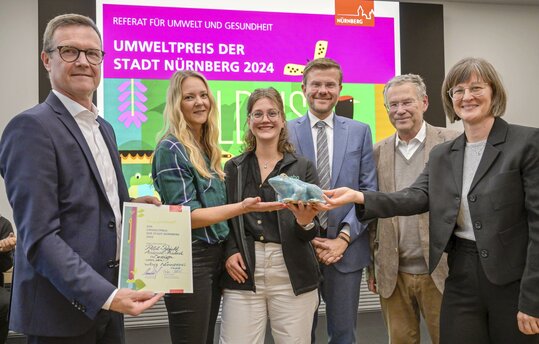wbg Nürnberg GmbH receives a certificate of recognition for its long-term pilot project Animal-Aided Design (AAD). AAD makes it possible to harmonize the protection and promotion of wildlife with modern urban planning. The basic idea is to incorporate the presence of certain animals into the planning process for renovations or new buildings.
The focus is on the Langwasser Südost district around Reinerzer Straße. Project manager Anja Vierle-Eberhardt and her colleague Magdalena Müller from wbg's gardening and landscaping department are concentrating on the needs of eleven species of wildlife there: swift, goldfinch, tree sparrow, lesser noctule (bat), brown-chested hedgehog, common pipistrelle, mosquito bat, sand lizard, willow sand bee, blue-green mosaic dragonfly (dragonfly) and dock moth (butterfly).
Habitat on the roofs
Sustainable habitats are to be created for these animal species in the outdoor facilities, but also on facades and roofs, offering food, protection and space. This is only possible if the aesthetics of the open spaces are changed: For example, a frequently mowed lawn gives way to a colorful flower meadow. In order to inform the residents of the neighborhood about the AAD, signs have been put up explaining what habitat is being created in the selected areas. Brochures and further content on the wbg website will follow.
At the award ceremony, wbg Managing Director Ralf Schekira emphasized: “We are delighted that our commitment in this area has been recognized. We are working intensively with the AAD to ensure that the topic of sustainability becomes increasingly important for us. The focus on environmental and species protection, which we have always had, is thus once again significantly strengthened - in line with our motto: We shape living spaces.”
Every two years, the City of Nuremberg presents the Environmental Award in recognition of outstanding achievements in environmental protection and the promotion of sustainable development that have an impact in the city area or have a connection to Nuremberg. Lord Mayor Marcus König explains: “Wilderness also exists in cities if we give it space. And everyone can do something: a wild flowering meadow is also simply wilderness. If, for example, we deliberately don't mow certain green spaces, then we also have to explain this plausibly to citizens.”


